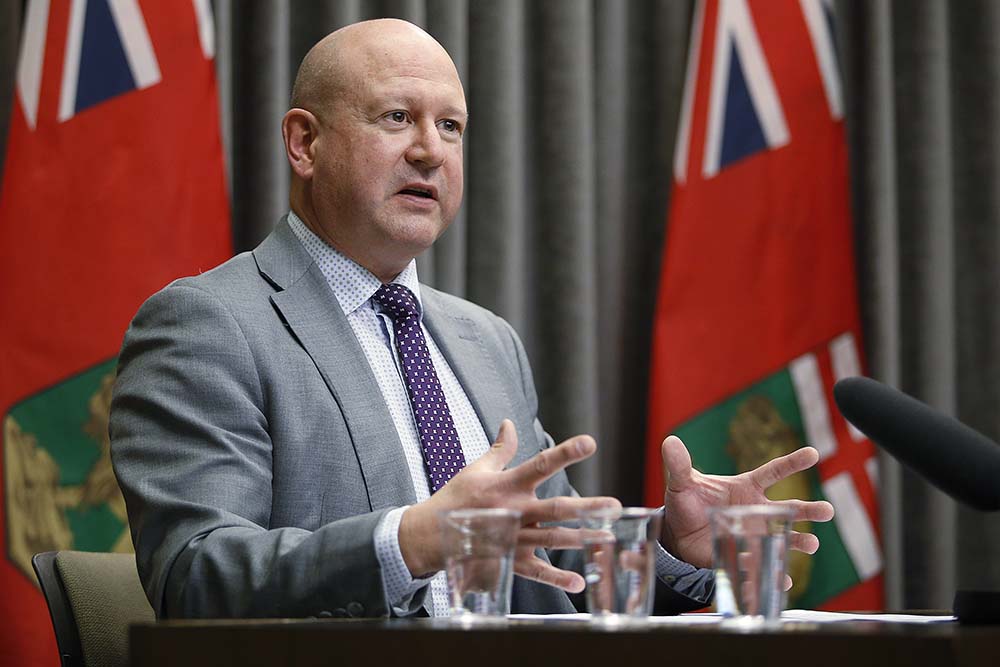Too early to tell if omicron has peaked: Roussin
Advertisement
Read this article for free:
or
Already have an account? Log in here »
We need your support!
Local journalism needs your support!
As we navigate through unprecedented times, our journalists are working harder than ever to bring you the latest local updates to keep you safe and informed.
Now, more than ever, we need your support.
Starting at $15.99 plus taxes every four weeks you can access your Brandon Sun online and full access to all content as it appears on our website.
Subscribe Nowor call circulation directly at (204) 727-0527.
Your pledge helps to ensure we provide the news that matters most to your community!
To continue reading, please subscribe:
Add Brandon Sun access to your Free Press subscription for only an additional
$1 for the first 4 weeks*
*Your next subscription payment will increase by $1.00 and you will be charged $20.00 plus GST for four weeks. After four weeks, your payment will increase to $24.00 plus GST every four weeks.
Read unlimited articles for free today:
or
Already have an account? Log in here »
Hey there, time traveller!
This article was published 19/01/2022 (1357 days ago), so information in it may no longer be current.
It is still too early to tell if the province has hit or passed the fourth-wave peak, says Manitoba’s top doctor.
The speed and nature of the omicron variant has changed how the province tracks and manages cases, chief provincial public health officer Dr. Brent Roussin said on Wednesday. While 919 new cases were reported yesterday, he re-iterated those numbers are not reliable as there are likely far more unreported cases.
Because of how quickly the virus spreads, the provincial government has shifted from containment to mitigation.

“That doesn’t mean all the work we put in over the last two years is in vain,” he said. “I thank all Manitobans who have done their part and stepped up. We are asking Manitobans to step up yet again.”
Last Wednesday, the province reported 1,478 new cases and the Wednesday before that 1,790. This may look like cases are dropping, but the province has changed its testing strategy over the last two weeks. Rapid testing performed at home is not being taken into consideration — only PCR tests and medically supervised rapid testing is being added to the daily case count.
Hospitalizations and deaths are still being used as the more accurate indicator of the virus’ spread and overall risks. While both hospitalizations and deaths are considered a lagging indicator the wave has peaked in some cases, Roussin said this virus moves so quickly, they can’t say for sure if the wave has peaked.
Roussin has hope the peak is coming, but there is still a significant amount of transmission happening. Everyone still has to be very cautious with contacts, he said. People still need to follow measures, such as wearing a mask, staying home when sick, testing if you suspect your symptoms are COVID and being vigilant about your contacts.
The best defence is still getting vaccinated. While it may not prevent outright infections, it still provides the best protection against severe outcomes.
“The numbers support this. You are three times more likely to be hospitalized if you are not fully vaccinated, 11 times more likely to be admitted to the ICU and 10 times more likely to die,” Roussin said.
As children return to school, parents can help slow the spread by making sure they get their first and second doses. Dr. Joss Reimer, medical lead for the province’s vaccine implementation task force, said there are clinics happening during school and after school in many districts, and parents can find out more from their school districts. This is especially important as the province prepares to administer second doses of the pediatric vaccine this week.
Vaccine uptake among adults is also a concern. While 92 per cent of Manitobans have had one dose and 82 per cent their second, only 62 per cent have had a booster shot. Among specific ages, there has been good uptake in the 70-plus age category for the booster, but not as many in the 50-to-69 age category.
“Once you are over 50, your risks for a severe outcome increase and over 60, they increase even more,” Reimer said.
There are many other at-risk groups that need to get their booster as soon as they can, including anyone over the age of 18 and has diabetes, those with heart conditions, kidney or liver problems and First Nations.
To underscore the effectiveness of vaccines, Reimer talked about new data from a few studies. One study from Israel showed the risk of long-term effects from COVID was far less in vaccinated than unvaccinated.
“The effects of the virus on the vaccinated [were] actually close to those never infected,” she said. “This is still being researched, but this is promising.”
Vaccine manufacturers are studying the virus to find ways to target it. There are some looking at focusing on parts of the virus that do not mutate as fast. Reimer said variants will be inevitable as it has demonstrated it is very effective at mutating. No one anticipated the omicron variant; many were expecting something closer to the delta variant, but omicron developed from the original strain. This caught a lot of scientists off-guard.
“The next question is, what will the next variant look like? Will it be more transmissible, or will it be more severe or have more of an impact on the vaccine effectiveness?,” Reimer said. “While omicron does look different, these vaccines are still able to produce an effective immune response that can recognize it and prevent severe outcomes.”
» kmckinley@brandonsun.com
» Twitter: @karenleighmcki1
